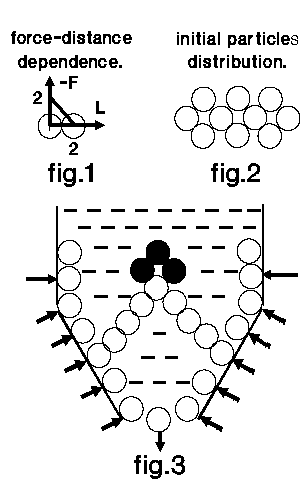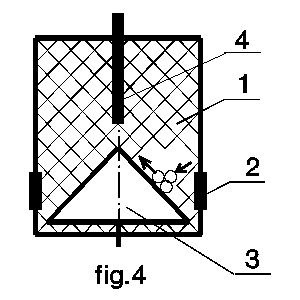It is an attempt to simulate as really as possible a crystal's
interatomic interaction under conditions described at
main page.
 Circular particles interact each other by the repulsive central
force (fig.1) and are initially distributed at equilibrium distances (fig.2).
The arrows (fig.3) show boundary particles movement. Bold elements are
motionless and simulate the stopping tip. Most of another particles
(simplified by dashed lines) flow free up or down. The particles opportunity
to exit down along the axis corresponds to the axial current attenuation
(see "one defect" appendix at main page).
Intercrystal non-conservative processes were simulated by a force that
is equal and opposite to the particle's velocity.
Circular particles interact each other by the repulsive central
force (fig.1) and are initially distributed at equilibrium distances (fig.2).
The arrows (fig.3) show boundary particles movement. Bold elements are
motionless and simulate the stopping tip. Most of another particles
(simplified by dashed lines) flow free up or down. The particles opportunity
to exit down along the axis corresponds to the axial current attenuation
(see "one defect" appendix at main page).
Intercrystal non-conservative processes were simulated by a force that
is equal and opposite to the particle's velocity.
The equations of 2D-motion were solved by simple Euler's method.
The method have first order of accuracy, but maximum forces developed in
a calculation don't change essentially in the calculation with the time step
tenfold bigger. So the calculations give quality and even quantity picture
of the system dynamics.
Great concentration of interactions to centre didn't develop at
the simulation (only by a factor of 1.5-2). Typical particle configuration,
appearing sometimes here, is a chain of particles (fig.3) translating
a load from the centre to the boundary almost without its decreasing.
It could be caused by "rigidity" of the boundary conditions. A support
particle, bound on real crystal surface, steps back under the load,
and neighboring particles will take a part of the load. Axially
symmetrical geometry also have to give more uniform force distribution.
The most significant result is the several hundred times force
multiplication in such configuration compared with free flow forces
defined by the frictional processes presence. The flow tendency
to "freeze" with big interaction inside confirms the main page
description.
Fig.3 gives more effective sample shape than main page one.
More close-packed initial particles distribution (than fig.2) decreased
the force maximum. These should influence sample's shape and substance.
Because the maximum forces don't depend essentially on boundary movement
velocity, the effect are statical rather than dynamical.
 One more version of sample (fig.4) could be proposed by the
interatomic force analysis. Now forces cumulate along slopes (generatrices)
of conical cathode (3). Electric field (order of its atomic value) stabilizes
the particles chain on the slopes, and cuts off small force components
*)
that are normal to the cone surface. At a plane normal to the axis,
if there are too many particles on a circumference of the cone, a part
of the particles step back so that the rest of them will not
interact within plain of the circumference.
One more version of sample (fig.4) could be proposed by the
interatomic force analysis. Now forces cumulate along slopes (generatrices)
of conical cathode (3). Electric field (order of its atomic value) stabilizes
the particles chain on the slopes, and cuts off small force components
*)
that are normal to the cone surface. At a plane normal to the axis,
if there are too many particles on a circumference of the cone, a part
of the particles step back so that the rest of them will not
interact within plain of the circumference.
The dielectric electron conductivity requirement (see
main page.)
is not valid now. It's unknown whether the stopping element (4) is needful.
*)- The components are proportional to interparticle intaraction
as interparticle distance to radius of the circumference, and if the cathode
is a macroscopic object, these forces can be neglected.
Сайт создан в системе
uCoz Circular particles interact each other by the repulsive central
force (fig.1) and are initially distributed at equilibrium distances (fig.2).
The arrows (fig.3) show boundary particles movement. Bold elements are
motionless and simulate the stopping tip. Most of another particles
(simplified by dashed lines) flow free up or down. The particles opportunity
to exit down along the axis corresponds to the axial current attenuation
(see "one defect" appendix at main page).
Intercrystal non-conservative processes were simulated by a force that
is equal and opposite to the particle's velocity.
Circular particles interact each other by the repulsive central
force (fig.1) and are initially distributed at equilibrium distances (fig.2).
The arrows (fig.3) show boundary particles movement. Bold elements are
motionless and simulate the stopping tip. Most of another particles
(simplified by dashed lines) flow free up or down. The particles opportunity
to exit down along the axis corresponds to the axial current attenuation
(see "one defect" appendix at main page).
Intercrystal non-conservative processes were simulated by a force that
is equal and opposite to the particle's velocity.
 One more version of sample (fig.4) could be proposed by the
interatomic force analysis. Now forces cumulate along slopes (generatrices)
of conical cathode (3). Electric field (order of its atomic value) stabilizes
the particles chain on the slopes, and cuts off small force components
*)
that are normal to the cone surface. At a plane normal to the axis,
if there are too many particles on a circumference of the cone, a part
of the particles step back so that the rest of them will not
interact within plain of the circumference.
One more version of sample (fig.4) could be proposed by the
interatomic force analysis. Now forces cumulate along slopes (generatrices)
of conical cathode (3). Electric field (order of its atomic value) stabilizes
the particles chain on the slopes, and cuts off small force components
*)
that are normal to the cone surface. At a plane normal to the axis,
if there are too many particles on a circumference of the cone, a part
of the particles step back so that the rest of them will not
interact within plain of the circumference.